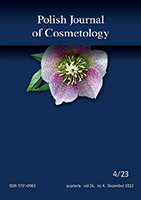search by
Copyright @ Pol J CosmetolFungal infections in the podologist´s practice - case studiesPrzemysław Dziewirz 1/, Monika Lemańska 1/, Anna Lubecka-Detka 2/, Katarzyna Wzorek 2/ 1/ Laboratoria Płockie Grupa ALAB sp. z.o.o w Płocku 2/ Gabinet Zdrowej Stopy Podopharm w Kielcach Summary Onychomycosis is the most common nail plate disease and occurs worldwide. Due to the ubiquity of fungi in the environment and many civilizational factors such as the aging of the population, metabolic diseases, eg diabetes, wearing synthetic clothes and footwear, the risk of fungal infections is high and may affect up to 10-20% of the human population. For the onychomycosis, dermatophytes are mainly responsible for the nails, less often yeast-like fungi and molds. Local and oral preparations are used in the treatment. Mycosis therapy is long and fraught with the risk of relapse. The treatment requires cooperation between the dermatologist, the patient and, more often, the podologist dealing with the development of the changed nail plate. Such cooperation leads to effective results of treatment of onychomycosis. Key words: onychomycosis, podologist, onycholysis |




